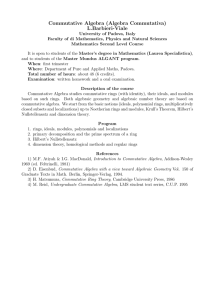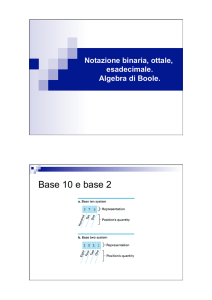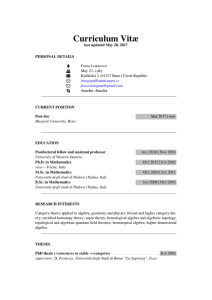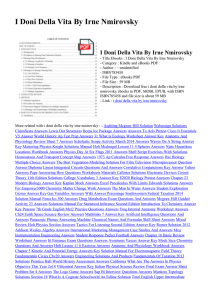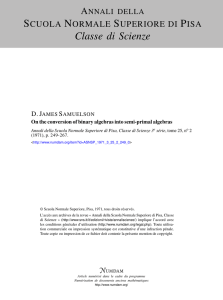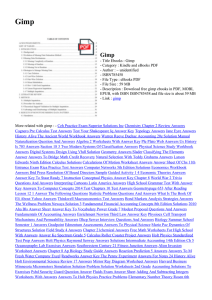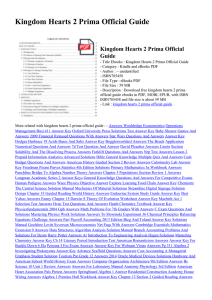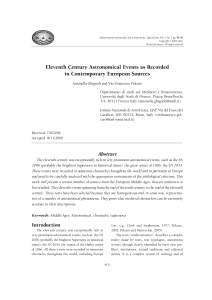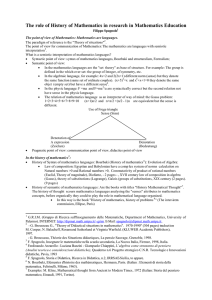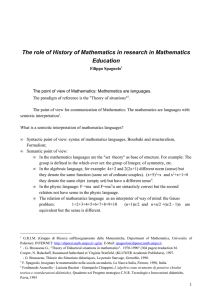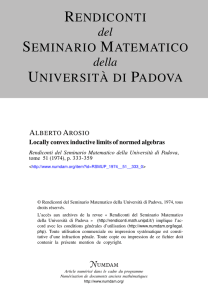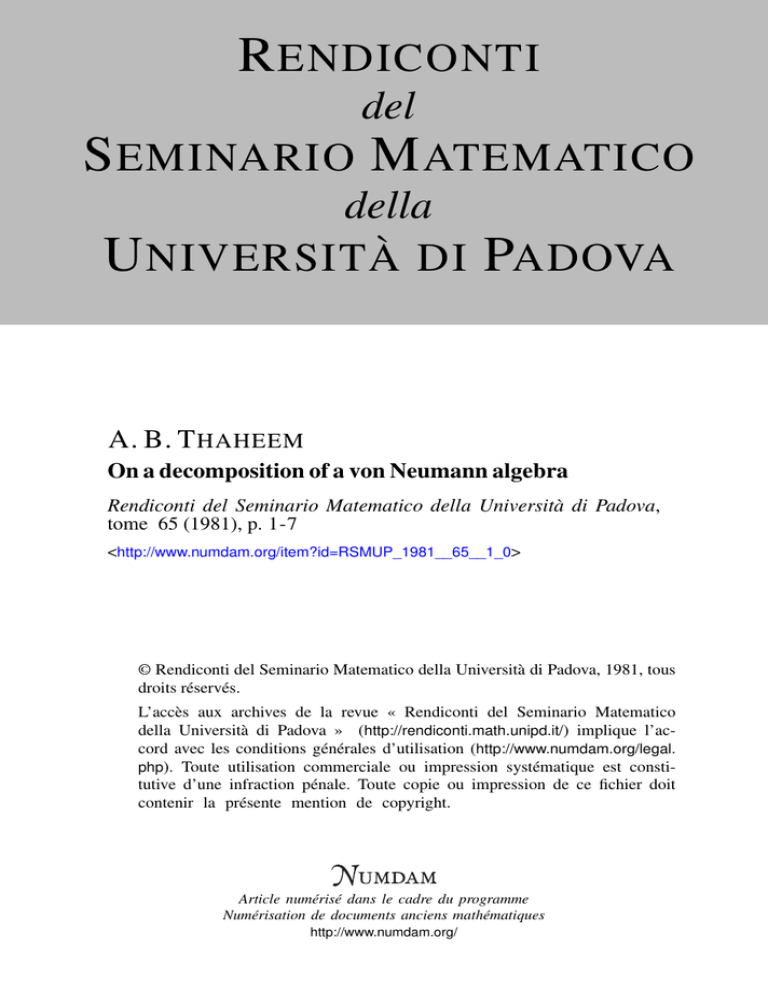
R ENDICONTI
del
S EMINARIO M ATEMATICO
della
U NIVERSITÀ DI
PADOVA
A. B. T HAHEEM
On a decomposition of a von Neumann algebra
Rendiconti del Seminario Matematico della Università di Padova,
tome 65 (1981), p. 1-7
<http://www.numdam.org/item?id=RSMUP_1981__65__1_0>
© Rendiconti del Seminario Matematico della Università di Padova, 1981, tous
droits réservés.
L’accès aux archives de la revue « Rendiconti del Seminario Matematico
della Università di Padova » (http://rendiconti.math.unipd.it/) implique l’accord avec les conditions générales d’utilisation (http://www.numdam.org/legal.
php). Toute utilisation commerciale ou impression systématique est constitutive d’une infraction pénale. Toute copie ou impression de ce fichier doit
contenir la présente mention de copyright.
Article numérisé dans le cadre du programme
Numérisation de documents anciens mathématiques
http://www.numdam.org/
On
a
Decomposition
of
a von
A. B. THAHEEM
Neumann
Algebra.
(*)
SUMMARY - Let M be a von Neumann algebra and S, T be *-automorphisms
of M satisfying an operator equation: Sx -ETx -~-- T-1 x for all x
in .M. Assume further that S and T commute. Then it is shown that M
admits a decomposition by a central projection e in M such that S(Me)
T(Me) and
e))
e)).
=
=
=
1. Introduction.
[4] we associate a strongly continuous one-parameter group
of a von Neumann algebra M with a
*-automorphisms
if
of
the
formula:
by
positive map ips
In
of
We show there that determines the group almost completely in the
are such groups then ’Ips = y~T
and
sense that if (Si :
(*) Author’s address:
P.O. Box 9480 Libya.
Faculty
of Science,
Garyounis Univ., Benghazi,
2
implies
We
that
Arveson’s theory of
spectral subspaces of automorphism
to
solve
5]
operator
equation
[1,
(1). We essentially obtain a
decomposition of M by a central projection e E if with
use
groups
E .M and t E .R.
This paper deals with a natural generalization of operator equation (1). Let S, T be any *-automorphisms of M satisfying the equation
for all x
Now there is no spectral subspace theory of S and T similar to the
one for automorphism groups in [1, 5]. However,y assuming the commutativity of S and T, we also obtain here a central decomposition
of If by a central projection e E .M with
If
T or S
T-1.
is a factor then S
The approach here is simpler than that of [4] but the advantage
there is that we do not assume the commutativity of automorphism
groups to obtain the decomposition of If in solving equation (1 ) .
The result is parallel to a well-known result of Kadison [2] which
says that if 6 is a Jordan isomorphism of a von Neumann algebra M,
then there is a central projection p E
such that 0 is an isomorphism
of .lVlp and anti-isomorphism of
This paper is organised in the following fashion: Section 2 contains
the decomposition of If relative to operator equation (2). In section 3
we consider a special case where the additional condition of commutativity of ,S and T may be suppressed to obtain the decomposition of If. In other words, in this case, equation (2) automatically
implies the commutativity of 8 and T. We conclude the paper with
an example of two isometries satisfying equation (2) on a Hilbert
space but they do not commute. Therefore, it is important to have
the structure more than the isometries on a Hilbert space.
=
=
3
2.
Decomposition
Let
be a
of if satisfying
We shall write
Denote by
R(T)
=
of
a von
Neumann
Neumann
von
algebra.
algebra and 8,
T be
*-automorphisms
(2) as : S + S-1=
T + T-1.
the null space of T and
for some y
the range space of T.
N(,T ) = ~x E lVl : Tx = 0~,
{x
Ty
=
DEFINITION 2.1. Put
Set M1 r1
Then
M2 = Mo.
Tx
Mo is non-empty because
1
and
e
and
Also
Mo are von
Neumann algebras. From equation (2) it is easy to see that S (M1)
Mi,
M2 and T(M2)
~2.
T(M1) ifi, S(M2)
Mo
=
=
=
=
==
_
=
LEMMA 2.2. If x
PROOF.
This
e
=
M1 and y
then
e
By assumption
implies
that
therefore, (Sx -
=
0.
Since S leaves M1 invariant so does S2. Furthermore, N(82- 1)
N(~’ - S-1) and ~(S2 -1 ) _ R(S - ,~-1). Then, by [3], the weakly
closed subalgebra Kx generated by .I~(~S2 - ~ ) is a twosided ideal in Ifj.
If e is the central projection in Mi such that .K~
M1e then f 1_ - e
for
is the largest projection such that
=
=
==
=
4
f 1 be the projections corresponding to S2 on Mg then by lem2.2, ee, el e 0. Since S leaves R(S 2013 S-1) invariant and hence
therefore, ~S’e e. Further, Se e Te = T-1 e. This implies that
We shall prove that e is in the center of Ms and eventually
Let el,
ma
=
=
=
=
e E
=
in the center of M.
LEMMA 2.3.
Mo .
Mo ,
E Mi , we have
If 2 and hence
PROOF. For any x
is
LEMMA
PROOF.
2.4. Mi + Ma is weakly dense in M.
ZVl1= N(S - T )
C N(~S’
- T-1) _
R(S-1 T -1 )
fore, by [3, proposition 1],
We
That
=
..1t22 = Mo. Similarly
are now
then it is easy to see that
8-1
T
is
.M~2~
again a *-automorphism, thereis weakly dense in M.
=
able to show the
LEMMA 2.5. The
following
projections e, e1
are
in the center of M.
PROOF. Since
therefore, e commutes with all the elements of 11M2. Also
0, therefore, e commutes with all the elements of ~112. Since Ml + M2 is dense in M
and therefore, by continuity e is in the center of M. Similarly e1 is
also in the center of M.
We notice that eM2Ç
Ml, therefore, Ml + 11~12 is dense in M
that
implies
Similarly ex 11T c 1~12 and
We combine the above lemmas to prove the following
THEOREM 2.6. Let S, T be *-automorphisms of a von Neumann
such that Sx -f- 8-1X
for all x e M. Assume
Tx +
that S and T commute, then there exists a central projection e in M
such that
T(ex) and s((1- e)x)
T-x((1- e)x).
algebra
=
=
=
PROOF.
+
Obviously M eM +
therefore, S(ex) T(ex). Also, (1 e) M
and
Since
=
=
(1- e
-
el M
+ (1
therefore ~’((1- e)x)
-
COROLLARY 2.7. If M is
for all x in M.
=
a
factor then Sx
=
=
Tx
-
e
Ml,
-
e1) M,
T-1((1- e)x).
or
Sx = p-lX
5
3.
Commutativity
of S and T.
In this section we consider a special case where the additional
condition of commutativity of S and T may be dropped from the
hypothesis of theorem 2.6 to get the decomposition.
Let A be a commutative Banach algebra and 8 an automorphism
of A. Let .A* denote the Banach space of all continuous linear functionals on A and ~’* the adjoint of ~’. Let d be the set of all complex
homomorphisms of A and A the set of all Gelfand transforms x, for
x E A. It is easy to see that 8*(LJ)
zty T*(4 ) Jy and Sx + 8-1X
Tx + p-1X if and only if
for all
+
+
x E A and
=
=
=
=
=
THEOREM 3.1. Let A be a commutative Banach algebra
T
be automorphisms with Sx +
Tx + T-"x for all x E .A. Then
and T commute.
=
PROOF. Put
Obviously Pi
Lx and .L2
and
P2
are
invariant under both S* and T*. Put
also invariant under ,S* and T*.
We shall prove that, in fact,
J.
Let h E A and x E A,
then
are
Suppose that h 0 LI u L2,
and
then
Further,y Ll U L2k A -
·
6
Now there
that
are
two
possibilities
for S*h and S*-lh in the
sense
either
or
Therefore,
) such that in
we
can
find
a
suitable
case
and
This combined with
in 1 such that in
case
(ii) contradicts (i). Similarly,
(b)
we can
choose A
Again this together with (ii) contradicts (i).
Therefore, in any case we must have
This shows that Ll U L2 = d .
It is immediate that S* and T* commute
for
J and x E A, we have
on
d
and, therefore,
This implies that STx - T,Sx E Ker (h) and hence
Tsx) E
This comradical (A) = {0}, therefore, STx
TSx for
pletes the proof of the theorem.
The following example shows that it is essential to have algebraic
structure to get the decomposition of theorem 2.6 (and also the commutativity of theorem 3.1).
E
=
EXAMPLE 3.2. Let H be a Hilbert
with 121 1 and 0 E, F 1 be projections
-
a
on
complex number
.~Z’. Define two linear
7
mappings S
and T
on
JT
as :
XEx +
S and T are invertible isometries on H with
Tx + T-’X.
and Sx +
If E and I’ are chosen such that and ~’ do not commute,
evidently ST ~ T,S’.
We conclude the paper with the following
=
then,
PROBLEM. For what class of algebras the condition of commutativity of automorphisms in the hypothesis of theorem 2.6 turns
out to be redundant?
Acknowledgements. The author is
for many useful discussions.
grateful
to Prof. A. Van Daele
REFERENCES
[1] W. ARVESON, On groups of automorphisms of operator algebras, J. Funct.
Analysis, 15 (1974), pp. 217-243.
[2] R. V. KADISON, Isometries of operator algebras, Ann. Math., 54 (1951),
pp. 325-338.
B. THAHEEM, Decomposition of a von Neumann algebra relative to a
*-automorphism, Proc. Edinburgh Math. Soc., 22, no. 1 (1979), pp. 9-10.
A. B. THAHEEM - L. VANHEESWIJCK, A completely positive map associated
to one-parameter groups of automorphisms of von Neumann algebras, preprint.
A. VAN DALE, Arveson’s theory of spectral subspaces, to appear in Nieuw
Archief voor Wiskunde.
[3] A.
[4]
[5]
Manoscritto
pervenuto
in redazione il 17 novembre 1979.

